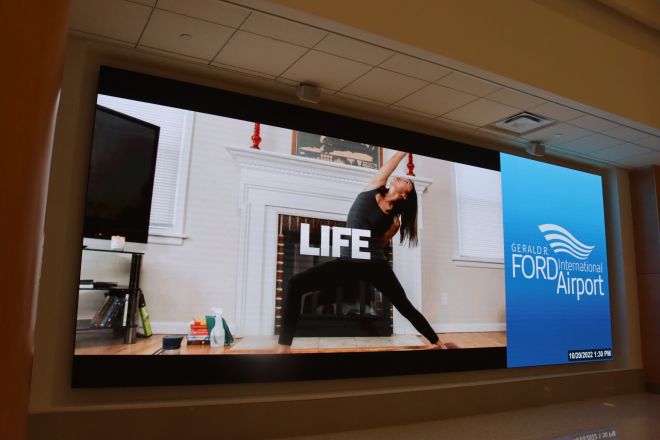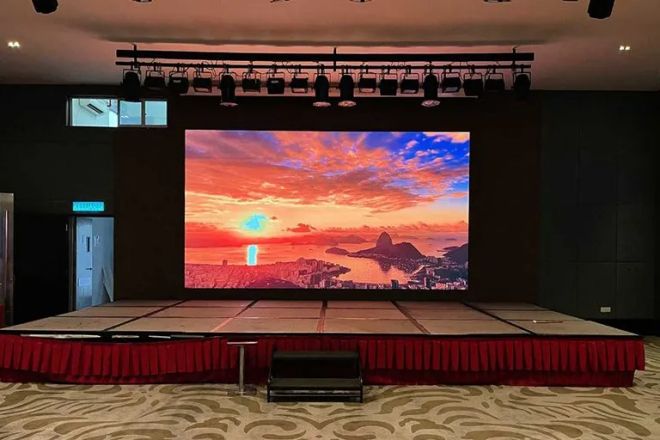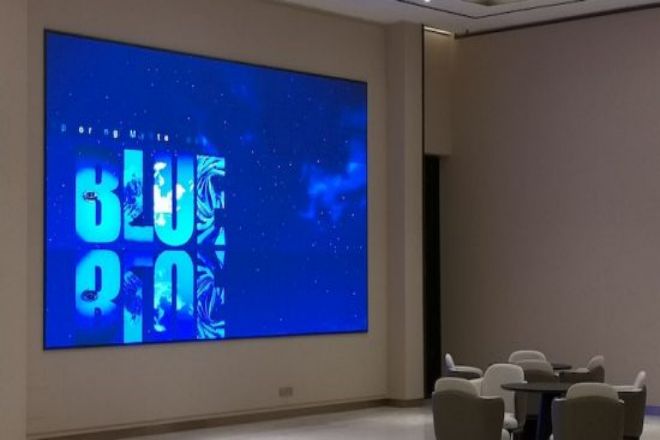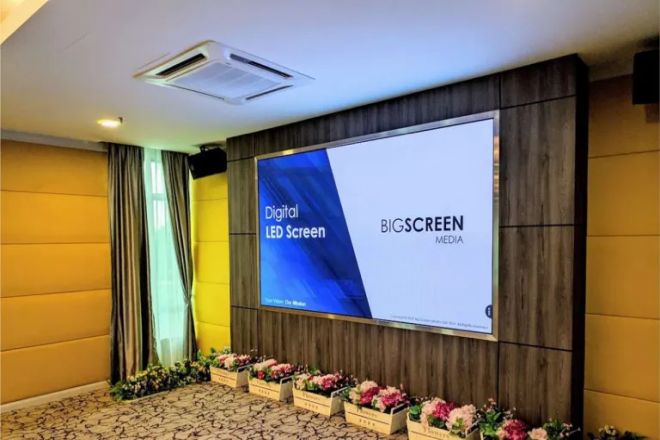序章

技術の継続的な発展により、 LED表示画面 屋内ディスプレイの重要なツールとなっています。高精細な画質、高輝度、多様な機能を備えた LED ディスプレイは、屋内広告、会議ディスプレイ、イベントのライブ放送などの分野で広く使用されています。
しかし同時に、屋内 LED ディスプレイを設置する際にはいくつかの問題もありますので、この記事ではよくある質問に一つずつ答えていきます。
1. 適切な設置場所をどのように選びますか?
屋内 LED ディスプレイの設置場所を選択する場合、次のような点に特に留意してください。
1). 使用シナリオと目的を決定する
商業用ディスプレイ:ショッピングモールや店舗などの商業施設でのディスプレイに使用する場合は、店舗の入口や廊下の中央など、お客様の出入りが多く見やすい場所に設置してください。
会議と展示会: 会議室や展示ホールでは、すべての聴衆がコンテンツを鮮明に見ることができるように、ディスプレイ画面を聴衆の視線の中央に設置する必要があります。
情報アナウンス:社内のアナウンスや通知のために、ホールや廊下、休憩所など、社員が頻繁に訪れる場所にディスプレイ画面を設置できます。
2). 視線と照明条件を考慮します。
視線: 視聴者がディスプレイの内容を見るために上や下を見る必要がないように、ディスプレイの設置位置が視聴者の目の高さに一致するようにします。
光:直射日光や強い照明にさらされる場所にディスプレイを設置すると、視聴者が画面の内容を見にくくなる可能性があるため、避けてください。同時に、ディスプレイ画面からの反射光が視聴者の視界を妨げないようにすることも必要です。
3) セキュリティと安定性
構造的に健全であること: 設置場所が構造的に健全であり、ディスプレイの重量と振動に耐えられることを確認します。
防火と放熱: ディスプレイの放熱を考慮し、設置場所の周囲に空気循環のための十分なスペースを確保してください。同時に、防火要件を満たす材料と設置方法を選択する必要があります。
4). メンテナンスと修理が簡単
アクセスのしやすさ: その後のメンテナンスや修理作業を容易にするために、アクセスしやすい設置場所を選択してください。
スペースを残す: ディスプレイを定期的に清掃またはメンテナンスする必要がある場合は、設置場所の周囲に十分なスペースがあることを確認してください。
5). 美学と調和
デザインスタイル: ディスプレイの外観やデザインスタイルと周囲の環境との調和を考慮し、設置場所が全体のデザインスタイルと一致するようにします。
色のマッチング: 可能であれば、周囲の環境の色と一致するか調和するディスプレイ フレームの色を選択します。
- 6). 規則や規制を遵守する
選択した設置場所が現地の建築基準法および火災安全規制に準拠していることを確認してください。
2. 設置場所のサイズに応じて LED ディスプレイのサイズをどのように決定しますか?

1) 設置場所に応じて LED ディスプレイのサイズを決定するには、複数の要素を考慮する必要があります。推奨される手順は次のとおりです。
設置スペースを測定します。
まず、設置場所の長さ、幅、高さを正確に測定します。壁、柱、ドア、窓など、周囲に存在する可能性のある障害物や制限を考慮するように注意してください。
視聴距離と視聴角度を決定します。
視聴者とディスプレイ間の視聴距離と視聴角度を考慮してください。一般的に、視聴距離が近いほど、ディスプレイ画面のサイズは大きくなります。視聴距離が遠い場合は、視聴効果を確保するために、より大きなディスプレイ画面が必要になる場合があります。
画面比率を決定します。
一般的な画面比率は 4:3、16:9 などです。使用ニーズと再生コンテンツの形式に基づいて、適切な画面比率を選択してください。たとえば、主に映画やビデオの再生に使用する場合は、16:9 の比率の方が適している可能性があります。
2). 最大寸法と最小寸法を計算します。
- 最大サイズ:
設置スペースの長さ、幅、高さに基づいて、設置可能なディスプレイの最大サイズを計算します。ディスプレイのベゼルや取り付けブラケットなどの追加スペースを慎重に考慮してください。
- 最小サイズ:
視聴距離と視聴角度に基づいて、鮮明さと視聴効果を維持できる最小の表示サイズを計算します。
- 適切なサイズを選択してください:
最大サイズと最小サイズの間で、予算、使用ニーズ、その他の要素に基づいて最も適切なディスプレイ サイズを選択します。より正確な計算が必要な場合は、専門的なディスプレイ サイズ計算ツールまたはソフトウェアを使用できます。
- 将来の拡張性を考慮する:
将来的にディスプレイを拡張またはアップグレードする必要がある場合は、サイズを選択する際に一定のスペースを確保したり、モジュール設計を検討して、将来的にディスプレイの数や領域を簡単に増やせるようにすることができます。
- 専門家に相談する:
適切なディスプレイ サイズの選択方法がわからない場合は、専門の LED ディスプレイ サプライヤーまたは設置会社に相談してください。特定のニーズと設置環境に基づいて、専門的な提案やソリューションを提供できます。
3.屋内用LEDディスプレイの構造はどのように選択すればよいですか?
屋内 LED ディスプレイの構造を選択する際には、ディスプレイの安定性、安全性、美観、使用上のニーズを確保するために、複数の要素を考慮する必要があります。屋内 LED ディスプレイの構造を選択する方法について、いくつかの提案を次に示します。
- 設置方法と耐荷重:
まず、壁掛け、ブラケット取り付けなど、ディスプレイ画面の設置方法を決定します。設置方法に基づいて、設置場所の耐荷重を評価し、構造がディスプレイの重量を安全に耐えられることを確認します。
設置場所の耐荷重が限られている場合は、アルミニウム合金などの軽量ディスプレイ構造材料を使用することもできます。
- 構造安定性:
使用中にディスプレイが揺れたり傾いたりしないように、安定性の高い構造を選択してください。
過酷な環境でも構造が安定するように、耐風性や耐震性を考慮してください。
- 放熱性能:
LED ディスプレイ画面は動作中に一定量の熱を発生するため、ディスプレイ画面が安定して動作できるようにするには、構造に優れた放熱性能が必要です。
放熱効率を向上させるために、放熱穴や冷却ファンを備えた構造設計を選択できます。
- 美学:
ディスプレイ画面の外観や全体的なデザインスタイルを考慮し、室内環境と調和した美しくエレガントな構造を選択します。
ディスプレイフレームの幅や色、背景の壁や他の装飾との調和にも注意してください。
- 保守性:
ディスプレイのその後の清掃や修理を容易にするために、メンテナンスが容易な構造設計を選択してください。
故障した部品の交換やディスプレイのアップグレードを容易にするために、構造の取り外し可能性とモジュール設計を考慮してください。
- 安全性:
構造が防火、避雷などの関連する安全基準および規制に準拠していることを確認します。
構造の安定性と安全性を確保するために、高品質の材料と製造プロセスを選択してください。
- 費用対効果:
使用ニーズと安全要件を満たすことを前提に、構造の費用対効果を考慮し、よりコストパフォーマンスの高い設計を選択します。
盲目的に低コストを追求し、構造上の安定性や安全性を無視しないように注意してください。
- 専門家のアドバイス:
LED ディスプレイ スクリーンの構造選択についてよくわからない場合は、専門の LED ディスプレイ スクリーン サプライヤーまたは設置会社に相談してください。彼らは、お客様の特定のニーズと設置環境に基づいて、専門的な提案とソリューションを提供できます。
4. 屋内 LED ディスプレイを設置する際に、十分な視覚条件を確保するにはどうすればよいでしょうか?

屋内 LED ディスプレイを設置する場合、視聴者がコンテンツを快適かつ明瞭に視聴できるように十分な視覚条件を確保するために、次の重要な手順と考慮事項があります。
- 最適な視聴距離と視聴角度を決定します。
LED ディスプレイのサイズと解像度に基づいて、最適な視聴距離を計算します。これは通常、ピクセル密度と視覚的な快適さに基づいて決定されます。
ディスプレイの垂直視野角と水平視野角の両方が、視聴者の視聴位置、特にメインの視聴者エリアをカバーしていることを確認してください。
- 障害物のない場所を選択してください:
設置場所には、柱、壁、その他の機器など、視聴者の視界を遮る可能性のある物体を避けてください。
遮蔽を回避できない場合は、遮蔽を最小限に抑えるためにディスプレイの角度や位置を調整することを検討してください。
- 光の条件を考慮してください:
屋内用 LED ディスプレイは適度な照明のある場所に設置し、強い直射光や反射光を避ける必要があります。
周囲の光が強すぎる場合は、遮光装置を設置したり、環境に合わせてディスプレイの明るさを調整したりする必要があります。
- ディスプレイの明るさとコントラストを調整します。
コンテンツが明瞭に表示されるように、周囲の光と視聴距離に基づいてディスプレイの明るさとコントラストを調整します。
視覚的な疲労を軽減し、視聴の快適さを向上させるために、明るすぎるディスプレイや暗すぎるディスプレイを避けてください。
- 色と解像度を考慮してください。
より鮮明で詳細な画像を表示するには、高解像度の LED ディスプレイを選択してください。
リアルで鮮明な画像を実現するために、ディスプレイの色再現が正確であることを確認します。
- 設置およびメンテナンスのためのスペースを確保します。
設置中は、設置、試運転、メンテナンスのために十分なスペースを確保してください。
将来のアップグレードや拡張の必要性を考慮し、追加のスペースを確保してください。
- 視聴者の視覚的な習慣を考慮してください。
視聴者の視聴習慣やニーズに応じて、表示画面の高さ、角度、位置を調整します。
たとえば、会議室や展示ホールでは、全員がコンテンツを見ることができるように、ディスプレイを聴衆の視線の中央に設置する必要があります。
- 専門的なソフトウェアを使用して視覚効果をシミュレートします。
設置前に、専門のソフトウェアを使用して、さまざまな位置、照明、角度でのディスプレイの視覚効果をシミュレートできます。
これにより、最適な取り付け場所をより正確に選択し、パラメータを調整できるようになります。
5. 屋内用 LED ディスプレイの設置手順は何ですか?
屋内 LED ディスプレイの設置手順は、主に次の段階で構成されます。
- 事前準備:
適切な設置場所を選択し、設置場所が LED ディスプレイのサイズと耐荷重要件を満たしていることを確認します。
壁の構造とサポート能力を評価して、ディスプレイの重量を支えられることを確認します。
安全検査を実施して、すべてのケーブルと電源コードが国および地域の安全基準に準拠していることを確認します。
- ブラケットを組み立てます。
メーカーが提供する設置マニュアルに従って、LED ディスプレイのブラケットまたは吊り下げシステムを正しく組み立てます。
ブラケットが LED ディスプレイをしっかりと保持でき、十分な安定性と耐荷重性を備えていることを確認してください。
- ディスプレイをインストールします。
LED ディスプレイ モジュールを正しい順序で接続します。
ケーブル接続が正しいことを確認し、逆接続や接触不良を避けてください。
信号伝送の安定性を確保するために、接続がしっかりと行われているかどうかを確認してください。
- 電源と制御カードを取り付けます。
LED電源と受信カードシステムをブラケットの鉄骨構造に固定します。
ディスプレイが信号を受信してコンテンツを正常に表示できるように、電源ケーブル、受信カード、ネットワーク ケーブルを接続します。
- デバッグとテスト:
接続が完了したら、電源テストを実行し、LED ディスプレイをオンにします。
明るい点、暗い点、その他の表示異常がないかを確認し、適時に確認して解決してください。
LED ディスプレイの正常な動作と表示効果を確認するために、包括的なテストを実施します。
- 修正と美化:
安定性と安全性を確保するために、必要に応じてディスプレイを固定します。
必要に応じて、周囲の環境と調和するように境界を美化または装飾することができます。
なお、設置環境はそれぞれ異なるため、実際の運用においては、状況に応じて適切な調整が必要になる場合があります。
同時に、設置プロセスの安全性と円滑性を確保するために、専門の設置チームに設置を依頼することをお勧めします。
6. 屋内 LED ディスプレイはどのようにメンテナンスすればよいですか?

屋内 LED ディスプレイのメンテナンスと保守は、長期にわたる安定した動作を確保し、耐用年数を延ばすための重要な対策です。以下に、重要なメンテナンスとケアの手順を示します。
- 毎日の清掃:
定期的に静電気防止の柔らかいブラシまたは専用のクリーニングクロスを使用してディスプレイの表面を清掃し、ほこりや汚れを取り除いてください。
ディスプレイの表面を傷つけないように、化学洗剤や水分を多く含んだ布は使用しないように注意してください。
- 環境検査:
ディスプレイ周囲の周囲温度と湿度が動作条件を満たしているかどうかを毎日確認してください。
ディスプレイのパフォーマンスと寿命に影響を与えないように、極端に高温または低温の環境でディスプレイを使用しないでください。
- 使用習慣:
ディスプレイ画面とサポート機器を正常に動作させるには、少なくとも週 2 回、1 回につき 2 時間使用してください。
ディスプレイを 14 日間連続して使用しない場合は、直接起動による損傷を防ぐため、再度使用する前にディスプレイを予熱してください。
- 定期点検:
小型の屋内スクリーンの場合は月に一度の点検をお勧めします。半屋外、屋外、大型の屋内外スクリーンの場合は週に一度の点検が必要です。
ディスプレイの電源線と信号線が適切に接触しているか、緩んでいたり損傷したりしていないかを確認します。
- 締結作業:
LED スクリーンは電力消費量の多いデバイスであるため、長期間使用すると熱と寒さの影響で部品が緩む可能性があります。
したがって、ディスプレイ画面のコンポーネントと接続部は、安定性と安全性を確保するために定期的に締め付ける必要があります。
- 防水・防湿:
ディスプレイは乾燥した通気性のある状態に保ち、湿気の多い場所での使用や保管は避けてください。
ディスプレイ画面が浸水したり湿気を帯びたりした場合は、すぐに電源を切り、専門家に修理を依頼してください。
- ソフトウェアの更新とバックアップ:
パフォーマンスと機能を向上させるために、ディスプレイの制御システム ソフトウェアを定期的に更新してください。
偶発的な損失や損傷を防ぐために、重要な表示コンテンツと設定をバックアップします。
- トラブルシューティング:
ディスプレイに不具合や異常が見つかった場合は、すぐに電源を切り、専門家に修理を依頼してください。
より大きな損傷や安全上の危険を避けるため、ディスプレイを自分で分解したり修理したりしないでください。
上記の対策を実施することで、屋内 LED ディスプレイ スクリーンを効果的にメンテナンスし、長期にわたる安定した動作を確保し、耐用年数を延ばすことができます。
結論
LED 屋内ディスプレイ スクリーンの設置は、設置プロセス中の正確性と安全性を確保するために、設置前に十分な準備が必要な包括的なプロジェクトです。適切な設置手順と予防措置を講じることで、LED ディスプレイ スクリーンが屋内環境で安定して確実に動作し、さまざまなディスプレイ アクティビティに高品質の視覚体験を提供できるようになります。
最後に、LEDディスプレイについてもっと知りたい方は、 ご連絡ください。
